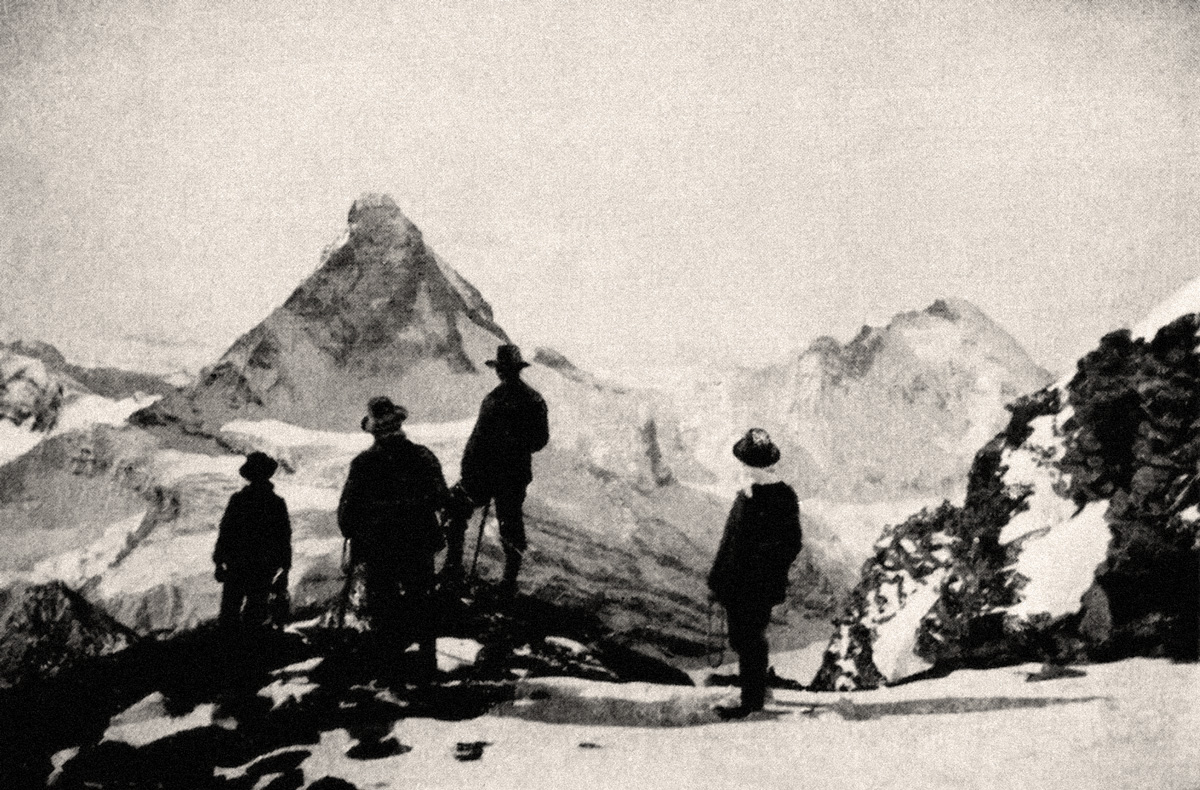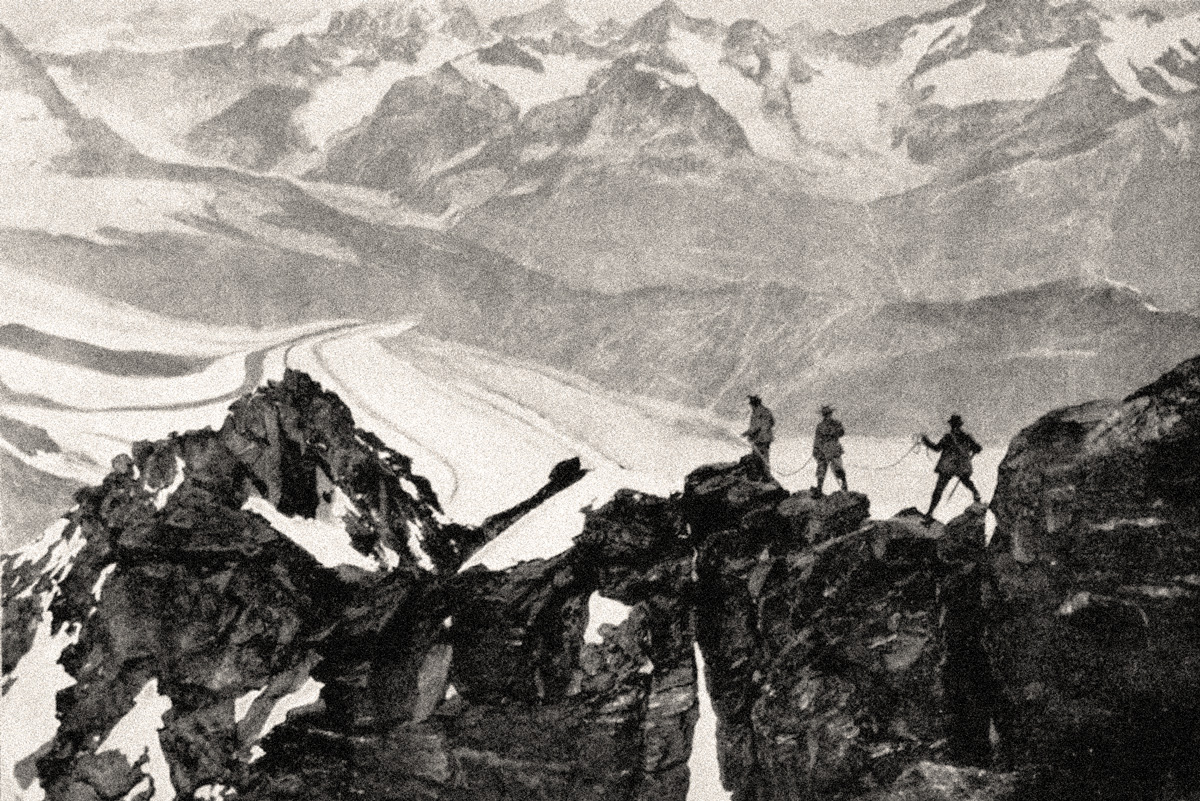
A few words about glaciers
Mrs. Aubrey Le Blond, née Elizabeth Hawkins-Whitshed, was an Irish alpinist and filmmaker who achieved remarkable ascents during an era when mountaineering was predominantly seen as a male pursuit. She documented her climbs in various books and photographs, contributing significantly to the establishment of the Ladies’ Alpine Club, where she became its inaugural president. This chapter on the fascinating and dangerous nature of glaciers is an extract from Le Blond’s book “True Tales of Mountain Adventures”, published in 1903. The opening image shows Aubrey Le Blond, in a photo taken by fellow mountaineer Joseph Imboden.
Of all the beautiful and interesting things mountain districts have to show, none surpass the glaciers.
Now a glacier is simply a river of ice, which never melts away even during the hottest summer. Glaciers form high up on mountains, where there is a great deal of snow in winter, and where it is never very hot even in summer. They are also found in northern lands, such as Greenland, and there, owing to the long cold winter and short summer, they come down to the very level of the sea.
A glacier is formed in this way: There is a heavy fall of snow which lies in basins and little valleys high up on the mountain side. The air is too cold for it to melt, and as more falls on the top of it the mass gets pressed down. Now, if you take a lump of snow in your hand and press it, you get an icy snow-ball. If you squeeze anything you make it warmer.
The pressing down of the great mass of snow is like the squeezing of the ball in your hand. It makes it warmer, so that the snow first half melts and then gradually becomes ice. You bring about this change in your snow-ball in a moment. Nature, in making a glacier, takes much longer, so that what was snow one year is only partly ice the next—it is known as nevé—and it is not until after several seasons that it becomes the pure ice we see in the lower part of a glacier.

A view of the Wellenkuppe, in a photo taken by Le Blond herself
One would fancy that if a quantity of snow falls every winter and does not all melt, the mountains must grow higher. But though only a little of the snow melts, it disappears in other ways. Some is evaporated into the atmosphere; some falls off in avalanches. Most of it slowly flows down after forming itself into glaciers. For glaciers are always moving. The force of gravity makes them slide down over their rocky beds.
They flow so slowly that we cannot see them move, in fact most of them advance only a few inches a day. But if a line of stakes is driven into the ice straight across a glacier, we shall notice in a few weeks that they have moved down. And the most interesting part of it is that they will not have moved evenly, but those nearest the centre will have advanced further than those at the side. In short, a glacier flows like a river, the banks keeping back the ice at the side, as the banks of a river prevent it from running so fast at the edge as in the middle.
A large glacier is fed by such a gigantic mass of snow that it is in its upper part hundreds of feet thick. Of course when it reaches warmer places it begins to melt. But the quantity of ice composing it is so great that it takes a long time before it disappears, and a big glacier sometimes flows down far below the wild and rocky parts of mountains and reaches the neighbourhood of forests and corn-fields.
It is very beautiful at Chamonix to see the white, glittering ice of the Glacier des Bossons flowing in a silent stream through green meadows. The reason that mountaineers have to be careful in crossing glaciers is on account of the holes, cracks, or, to call them by their proper name, crevasses, which are met with on them.
Ice, unlike water, is brittle, so it splits up into crevasses whenever the glacier flows over a steep or uneven rocky bed. High up, where snow still lies, these chasms in the ice are often bridged over, and if a person ventures on one of these snow bridges it may break, and he may fall down the crevasse, which may be so deep that no bottom can be found to it.

One of Le Blond’s ascents up the pink mountains, in an image taken by the mountaineer herself.
He is then either killed by the fall or frozen to death. If, as I have explained before, several climbers are roped together, they form a long string, like the tail of a kite, and not more than one is likely to break through at a time. As the rope is—or ought to be—kept tightly stretched, he cannot fall far, and is easily pulled out again.
The snow melts away off the surface of the glacier further down in summer. It is on this bare, icy stream, scarred all over with little channels full of water running merrily down the melting rough surface, that the ordinary tourist is taken when he visits a glacier during his summer trip to Switzerland. You will notice in most of the photographs of glaciers black streaks along them, sometimes only near the sides, sometimes also in the centre. These are heaps of stones and earth which have fallen from the mountains bordering the glacier, and have been carried along by the slowly moving ice.
The bands in the centre have come there, owing to the meeting higher up of two glaciers, which have joined their side heaps of rubbish, and have henceforward flowed on as one glacier. The bands of piled up stones are called moraines, those at the edge being known as lateral moraines, in the centre as medial moraines, and the stones which drop off the end (or snout) of a glacier, as terminal moraines.
Besides these compact bands, we sometimes find here and there a big stone or boulder by itself, which has rolled on to the ice. Often these stones are raised on a pedestal of ice, and then they are called “glacier-tables”. They have covered the bit of ice they lie upon, and prevented it from melting, while the glacier all round has gradually sunk. After a time the leg of the table begins to feel the sun strike it also. It melts away on the south side and the stone slips off. A party of climbers, wandering about on a glacier at night or in a fog, and having no compass, can roughly take their bearings by noticing in what position these broken-down glacier-tables lie.
Occasionally sand has been washed down over the surface of the ice, and a patch of it has collected in one place. This shields the glacier from the sun, the surrounding ice sinks, and eventually we find cones which are lightly covered with sand, the smooth ice beneath being reached directly we scratch the surface with the point of a stick.
It is difficult to realise the enormous size of a large glacier. The Aletsch Glacier, the most extensive in the Alps, would, it has been said, if turned to stone, supply building material for a city the size of London.
With regard to the movement of glaciers, the entertaining author of “A Tramp Abroad” mildly chaffs his readers by telling them that he once tried to turn a glacier to account as a means of transport. Accordingly, he took up his position in the middle, where the ice moves quickest, leaving his luggage at the edge, where it goes slowest.

A view of the Wellenkuppe, in a photo taken by Le Blond herself.
Thus he intended to travel by express, leaving his things to follow by goods train! However, after some time, he appeared to make no progress, so he got out a book on glaciers to try and find out the reason for the delay. He was much surprised when he read that a glacier moves at about the same pace as the hour hand of a watch!
Many thousands of years ago there were glaciers in Scotland and England. We are certain of this, as glaciers scratch and polish the rocks they pass over as does nothing else. Stones are frozen into the ice, and it holds them and uses them as we might hold and use a sharply-pointed instrument, scratching the rock over which the mighty mass is slowly passing. In addition to the scratches, the ice polishes the rock till it is quite smooth, writing upon it in characters never to be effaced the history of past events.
Another thing which proves to us that these icy rivers were in many places where there are no glaciers now, is the boulders we find scattered about. These boulders are sometimes of a kind of rock not found anywhere near, and so we know that they must have been carried along on that wonderful natural luggage-train, and dropped off it as it melted.
We find big stones in North Wales which must have come on a glacier beginning in Scotland! Glacier-polished rocks are found along the whole of the west coast of Norway, and there are boulders near Geneva, in Switzerland, which have come from the chain of Mount Blanc, 60 miles away.
So you see that the glaciers of the Alps are far smaller than they were at one time, and that in many places where formerly there were huge glaciers, there are to-day none. The Ice Age was the time when these great glaciers existed, but the subject of the Ice Age is a difficult and thorny one, which is outside the scope of my information and of this book.
Recent articles

Southern California is many things. Quite infamously, it is known as a landscape defined by the automobile, from the emergence and diffusion of the highway system to fast food burgers, and the suburbanization of the United States. Walking this place then, would seem not only inconvenient, but ill advised. In… Read more »

What is today known as ‘whistleblowing’ could once take the form of interacting with a threatening gaze carved into the city wall. It is the case of the ‘boche de Leon’ or ‘lion’s mouths’ disseminated by the old Venetian Republic throughout its territory to suppress illegal activities. Through a close… Read more »

As he navigates through the recurrent lockdowns of the pandemic, stranded between hitchiking and muggings, job hunting and separations, Fabio Valerio Tibollo rediscovers photography as a powerful coping mechanism. Recording everything that happened around him for one year straight, from attending momentous events to finding curiosity in shots of simple living,… Read more »

